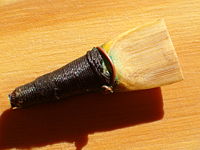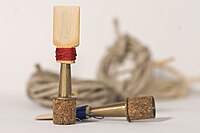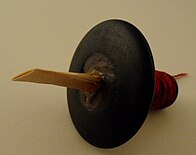 Bassoon reeds, showing the oval opening (bottom left), which is actually a vesica piscis
Bassoon reeds, showing the oval opening (bottom left), which is actually a vesica piscis
A double reed is a type of reed used to produce sound in various wind instruments. In contrast with a single reed instrument, where the instrument is played by channeling air against one piece of cane which vibrates against the mouthpiece and creates a sound, a double reed features two pieces of cane vibrating against each other. This means, for instruments with the double reed fully exposed, that the air flow can be controlled by the embouchure from the top, bottom and sides of the reed. The term double reeds can also refer collectively to the class of instruments which use double reeds.
Structure and dimensions
The size and shape of the reed depend on the type of double-reed instrument which is of two groups, conical and cylindrical. Even within families of instruments, for example, the oboe family, the reed for the oboe is quite different from that for the cor anglais (English horn).
Oboe reeds are usually 7 mm (0.3 in) in width, while bassoon reeds are wider, from 13.5 to 15.9 mm (0.53–0.63 in). Since the width of a reed affects its sound and response, reed makers experiment constantly to achieve the results they desire. Reed length, which broadly affects pitch, is much less consistent globally, as different orchestras tune to different frequencies. Auxiliary double reeds such as English horn and contrabassoon have their own sets of measurements, which are subject to the requirements of the player.
-
 Bagpipe of Portugal reed (gaita transmontana)
Bagpipe of Portugal reed (gaita transmontana)
-
 Bassoon reed
Bassoon reed
-
 Bombard reed
Bombard reed
-
 Crumhorn reed
Crumhorn reed
-
 Duduk reed
Duduk reed
-
Dulzaina reed
-
 Gralla reed
Gralla reed
-
 Oboe reed
Oboe reed
-
 Piffero reed
Piffero reed
Materials
For the reeds of European instruments, cane from Arundo donax, a wetland reed species traditionally from southern France, is commonly used. The reeds of non-European instruments can be made from similar wetland grasses, bamboo or young leaves from toddy palm trees. For example, the reed of Japan's hichiriki can be made from either mountain bitter bamboo or Phragmites australis, the latter is a softer cane than Arundo donax. When soft materials are used, adding layers to the reed can increase the stiffness while also maintain suppleness; for example, Myanmar's hne reed can have up to six layers of leaves from the palmyra palm tree which technically transform the double reed into a sextuple reed.
It is also possible to make reeds from synthetic materials such as polypropylene, which tend to last longer because they are less sensitive to temperature and humidity fluctuations. However, since the tone quality is dissimilar to that of a cane reed, synthetic reeds are not favoured by professional musicians.
Construction
A variety of tools are used for splitting, chopping, gouging and shaping the cane in the reed-making process.
Example: Bassoon
For bassoon reeds, tubes of cane are first split lengthwise then gouged to a certain thickness using a gouging machine. The chosen piece of cane is then cut to shape using a flat shaper and the centre portion is thinned (profiled) using a profiling machine which could be as simple as a wooden dowel and scraping knife to sophisticated machines with planes on a rod and a barrel to hold the cane that has accuracy down to .001" . The cane is folded end to end to form the two blades of the reed. The unprofiled end of the cane is shaped into a tube with the aid of a mandrel and bound with three (or four in some reed making techniques) strategically placed wires. A turban made out of thread is added on the third wire. It provides a hand hold for the reed that is not a sharp wire. The folded tip is cut off to allow the blades to vibrate and final adjustments to the interior of the reed using a reamer to precisely finish the tube to fit the bocal dimensions, and to the exterior (blade) using a reed-scraping knife or tip profiler, are carried out. The reed is then ready to fit to the bocal of the bassoon. The parts of the bassoon reed starting at the tip are: tip, blade, collar (where the profiled cane ends and throat begins), throat, 1st wire, 2nd wire (where throat ends and tube begins), 3rd wire, and butt (where the tube ends).
Example: Oboe
The construction of double reeds for the oboe family of instruments is similar in principle: like the bassoon's reeds, they consist of two pieces of cane fastened together with an opening at the tip. However, because the oboe does not have a bocal, the cane must be fastened to a metal tube (the staple), the lower half of which is normally surrounded by a piece of cork. The staple is then inserted into the farrow at the upper end of the oboe.
Ready-made reeds
Players can buy reeds either ready-made, or in various stages of formation, such as part-scraped, reed blanks, or buy the staples and cane separately. Cane is sold in several forms: as tubes, gouged, gouged and shaped, or gouged and shaped and profiled. Bassoon cane has the further option of being profiled before purchase. There are also many options with regard to staples and shaping equipment, which all have a subtle effect on the tone quality a reed will produce.
Reed variability
Differences in reed construction that may be visually minor can have a substantial impact on the sound produced by the reed, and as a consequence professional double-reed players must exercise meticulous craftsmanship in creating a suitable-sounding reed for whatever repertoire they are playing, with yet further considerations such as whether the player is principal or sectional, or whether the reed will be suitable for every item on the program. Environmental factors such as humidity and temperature also affect the performance of a double reed. Adjustments to reeds are, consequently, very frequent among double-reed musicians.
The reedmaking culture varies between countries, cities, and individuals, and the reedmaker accepts that the life of each reed is extremely short. Among oboists, there are several distinct schools of reedmaking, notatably the American and European schools. American, or "long scrape" reeds feature two visible "windows" of removed cane separated by a central spine, whereas European or "short scrape" reeds typically feature a more homogenous, tapered thickness across the entire reed. The construction of the American reed can help facilitate a "darker" timbre, whereas European reeds may foster a "brighter" sound.
Playing
The orchestral double reeds all employ a similar embouchure. Players pull their lips over their teeth to protect the reed from their teeth, and then vibrate the blades of the reed by blowing, while controlling the timbre and pitch with constant micromuscular pressure adjustments from the muscles of the mouth and jaw. Articulation is achieved by occluding the mouth of the reed with the tongue and then releasing it, with extended techniques such as double tongue, flutter tongue and growl all possible as on the other woodwind families.
The principal difference between double-reed embouchures – both between and within instrument families – is in the positioning of the rolled-in lips, and the musculature employed to control a sound. Oboe reeds, being much longer relative to their width, require concentrated pressure near the tip with more pressure from the sides of the mouth, whereas bassoon reeds are played with lips slightly more pouted and not necessarily aligned vertically. Similarly, the Armenian duduk does not require rolled-in lips and the control of the air flow is distributed toward the lower half of the cheeks.
All double-reed players employ and develop muscles at the back of the mouth to control their intonation via adjustments to the shape and pressure of the oral cavity surrounding the reed.
Instruments
Period
There are three main groups of instruments based on the methods of playing: blowing directly into the reed, partially blowing into the reed, and not blowing directly into the reed.
| Reed fully outside | Reed partially enclosed in a pirouette | Reed enclosed in a windcap |
|---|---|---|
Orchestral
| Bassoon | Heckelphone | Oboe | Sarrusophone |
|---|---|---|---|
Other
| Instrument | Region(s), best-known for |
|---|---|
| algaita | West Africa |
| aulos | Greece |
| bagpipes | Scotland |
| balaban | Iran |
| bombard | Brittany |
| bishgüür | Mongolia |
| charumera | Japan |
| cromorne | France |
| duduk | Armenia |
| dulzaina | Spain |
| fadno | Sámi |
| gaita transmontana | Portugal |
| guan | China |
| gralla | Spain |
| gyaling | Tibet |
| hne | Myanmar |
| hichiriki | Japan |
| hojok | Korea |
| kèn (also, kèn bầu) | Vietnam |
| lupophon | Germany |
| mey | Turkey |
| mizmar | Egypt |
| nadaswaram | India |
| pey au | Cambodia |
| piffero or piffaro | Italy |
| pí tơm | Vietnam |
| pi nai | Thailand |
| piri | Korea |
| pommer | Germany |
| rhaita | Africa |
| saronen | Indonesia |
| selompret | Indonesia |
| shehnai | India |
| sralai | Cambodia |
| sopila | Croatia |
| sorna | Iran |
| suona | China |
| surnay | Middle East |
| tangmuri | India |
| tárogató | Hungary, Romania |
| tenora | Spain |
| tible | Spain |
| taepyeongso | Korea |
| tromboon (trombone with reed) | United States |
| zurna | Middle East |
Double-reed societies
External links
See also
References
- "The structure of the oboe: The double-reed mechanism". Musical Instrument Guide. Yamaha Corporation.
- Wolfe, Joe. "Double reed acoustics: oboe, bassoon and others". Music Acoustics. UNSW Sydney, School of Physics. Retrieved 3 October 2022.
- Jähnichen, Gisa; Yoshitaka, Terada (2019). Double reeds: Along the Great Silk Road. 25th International Council for Traditional Music (ICTM) Colloquium, Double-reeds of the Silk Road: The Interaction of Theory and Practice from Antiquity to Contemporary Performance. Berlin, Germany: Logos Verlag Berlin. pp. i–vi. ISBN 9783832548865.
- ^ Tsuji, Kinko; Müller, Stefan C (31 May 2021). Physics and music: Essential connections and illuminating excursions. Cham, Switzerland: Springer. pp. 103, 181–182, 185. ISBN 9783030686758.
- ^ Buccur, Vochita (2019). Handbook of materials for wind musical instruments. Springer International Publishing. pp. 187, 255, 574. ISBN 9783030191757.
- ^ Hartenberger, Aurelia (n.d.). "Mongolia 'Bishgüür'". The Hartenberger World Musical Instrument Collection. Retrieved 26 October 2022.
- Kapuściński, Jarosław; Rose, François (2020). "Hichiriki". Orchestration in Gagaku music. Ensemble Reigakusha. Retrieved 6 October 2022.
- Jeltsch, Jean; Howell, Robin; Brown, Barnaby (2018). "Hichiriki reeds". The workshop of Dionysus. Retrieved 7 October 2022.
- "Hnè, late 19th century, Burmese". The MET (The Metropolitan Museum of Art). 1 January 2022. Retrieved 25 October 2022.
- "Wind instrument 'Hne'". Linden-Museum Stuttgart / Staatliches Museum für Völkerkunde. 1 January 2020. Retrieved 25 October 2022.
- Légère, Guy; Kortschot, Mark (2022). "Need to know: Why they work". Légère Reeds. Ontario Canada. Retrieved 6 October 2022.
- ^ "Guide to oboe reed making" (PDF). Concordia University Irvine, Music Department. California, United States: Lyon Oboe Studio. 2021.
- Schlesinger, Kathleen (1911). "Reed Instruments" . In Chisholm, Hugh (ed.). Encyclopædia Britannica. Vol. 22 (11th ed.). Cambridge University Press. p. 974.
- Schillinger, Christin (14 December 2015). Bassoon reed making: A pedagogic history. Bloomington, Indiana, United States: Indiana University Press. ISBN 978-0253018151.
- ^ Rothwell, Evelyn (2018). Guide to oboe reed making. Evelyn Rothwell's Guide to Oboe Reed Making. Vol. III. London: Howarth of London. pp. 1, 5–8, 45.
- ^ Fiala, Michele; Schuring, Martin (27 November 2020). Great oboists on music and musicianship. Oxford University Press. ISBN 978-0190915100.
- Chloe Veltman (20 April 2020). "Oboe reeds". BBC Radio 4 (Podcast). The Boring Talks. Publisher. 51. Retrieved 5 October 2022.
- Ledet, David (2009). Oboe Reed Styles, Theory and Practice. Indiana University Press. ISBN 9780253213921.
- Evans, Nicole. "A Comparison of Traditional American, German and French Oboe Reeds". Undergraduate Theses, Professional Papers, and Capstone Artifacts – via The University of Montana.
- Griswold, Harold G (2015). Teaching woodwinds. Taylor & Francis. pp. 22–23. ISBN 9781317343707.
- Millican, Si (2012). Starting out right: Beginning band pedagogy. Scarecrow Press. pp. 59–60. ISBN 9780810883024.
- Nercessian, Andy (2001). The duduk and national identity in Armenia. Scarecrow Press. pp. 115–117. ISBN 9781461672722.
- "Oboe: Two worlds of sound". Vienna Symphonic Library. Vienna, Austria. 2022. Retrieved 6 October 2022.
- Pagliaro, Michael J (2012). The musical instrument desk reference: A guide to how band and orchestral instruments work. Scarecrow Press. pp. 74–75. ISBN 9780810882713.
- Hartenberger, Aurelia (n.d.). "Double reed". The Hartenberger World Musical Instrument Collection. Retrieved 5 October 2022.
- Carroll, Paul (2017). Baroque woodwind instruments: A guide to their history, repertoire and basic technique. Taylor & Francis. pp. 88–91.
- Rech, Adelheid (2021). "Music in the daily life of Vermeer: The shawm (2)". Essential Vermeer 3.0. Retrieved 5 October 2022.
- Szwajgier, Agnieszka (2019). "Renaissance wind instruments with a double reed, part 1". Notes Muzyczny. 2 (12): 9–32. doi:10.5604/01.3001.0013.7164. S2CID 212926747. Retrieved 6 October 2022.
{{cite journal}}: Cite journal requires|journal=(help) - Szwajgier, Agnieszka (2020). "Renaissance wind instruments with a double reed, part 2". Notes Muzyczny. 1 (13): 9–27. doi:10.5604/01.3001.0013.7164. S2CID 212926747. Retrieved 6 October 2022.
{{cite journal}}: Cite journal requires|journal=(help) - Burgess, Geoffrey; Haynes, Bruce (2004). The oboe. Yale University Press. pp. 24, 256. ISBN 9780300093179.
- "Bishgüür, 1987, Ulan Baran, Mongolian". The MET (The Metropolitan Museum of Art). 1 January 2022. Retrieved 26 October 2022.
- Provine, Robert C; Tokumaru, Yoshihiko; Lawrence Witzleben, John, eds. (22 November 2017). The Garland Encyclopedia of world music: East Asia: China, Japan, and Korea. Taylor & Francis. ISBN 9781351544290.
- "Charumera". Catalog I. Tokyo, Japan: Music Department, Tokyo National University of the Arts. 2014. 591. Retrieved 6 October 2022.
- Haynes, Bruce (2001). The eloquent oboe: A history of the hautboy 1640-1760. Oxford University Press. p. 24. ISBN 9780198166467.
- Keen, Palmer (2018). "Ramé reeds: Madura's sound of saronen". Aural archipelago: Field recordings from around Indonesia. Retrieved 6 October 2022.
- Sutton, Anderson (1986). The crystallization of a marginal tradition: Music in Banyumas, West Central Java. Yearbook for Traditional Music. Vol. 18. Cambridge University Press. pp. 115–132. doi:10.2307/768524. JSTOR 768524. S2CID 193009606.
| Double reed instruments | |
|---|---|
| (also includes those with quadruple and sextuple reeds; does not include bagpipes) | |
| European classical (modern) | |
| European classical (historical) | |
| African traditional | |
| Asian traditional | |
| European traditional | |
| American traditional | |
| Reed aerophones | |||||
|---|---|---|---|---|---|
| Double reed |
| ||||
| Single reed |
| ||||
| Free reed |
| ||||
| Other | |||||